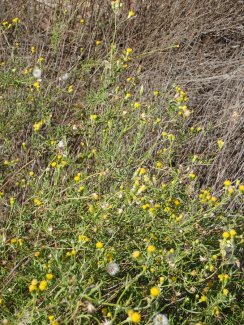South Africa, primarily the Western and Southern Cape, but also the Northern Cape.
Senecio angustifolius (Thunb.) Willd. is an erect perennial herb to shrub, with slender branches, up to 1 m tall, 2 m wide, at maturity woody at base, with rounded to vertically elliptic lenticels. Stem: Several from base, upper green, ridged to narrowly winged, +- glabrous proximally, glabrous to white-tomentose distally. Leaf: distributed mainly in upper stems, sessile, 10–35 mm, 1–2 mm wide, linear to very narrowly lanceolate to oblanceolate, base tapered or not, often auriculate, margins minutely dentate, rolled under, sometimes covering most or all of lower surface, thinly hairy of both surfaces, with tufts of white hairs often present in axil and leaf base. Inflorescence: heads disciform, in corymb clusters of (1) 2-4; involucre short-cylindric to cup-shaped, generally overtopping shoots, typically with small tufts of white hairs at base and on peducles, phyllaries 12--16, +- 5–6 mm, green with 1–2 central, yellowish veins, veins enlarged in central upper region, outer phyllaries narrower with narrow, tannish wings, inner phyllaries wider with wide, translucent wings, both often minutely brown- to black-tipped; basal, outermost phyllaries [calyculus] reduced, 1–2.5 mm. Flowers: 50-60 per head, pistillate and disk intermixed; corolla minutely lobed, ray 0. Fruit: 2–2.8 mm, upwardly appressed hairy in grooves between ribs.
California ecology: Alluvial washes, stragglers in coastal scrub or chaparral; Elevation: 5–482 m. Flowering Time: All months.
This species is native to South Africa, where it grows on rocky slopes and flats. It has been found sparingly in southern California and Mexico.
None
